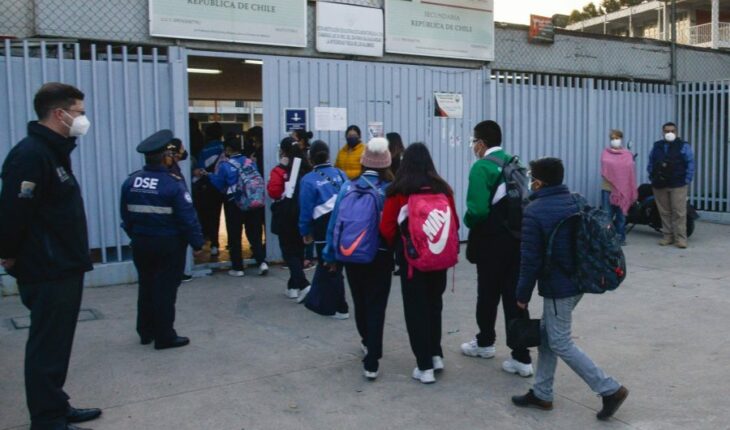The administration of Andrés Manuel López Obrador disappeared the Program of Full-Time Schools, which gave food and extracurricular classes in extended hours to 3.6 million students, to invest that budget in its new infrastructure program La Escuela es Nuestra, despite the irregularities detected in its second year of operation, such as the lack of certainty about the destination of one of every two pesos it received.
According to the Superior Audit of the Federation (ASF), there is no evidence that 573 million pesos from La Escuela es Nuestra have been spent to improve the infrastructure of the campuses, the objective of the program. This means half of the thousand 187 million pesos of the audited budget in 2020.
On the other hand, Full-Time Schools – started in 2006 and which had grown gradually over the next 12 years, focused mainly on the most marginalized areas of the country – managed to improve school performance, according to the latest review of the National Council for the Evaluation of Social Development Policy (Coneval), carried out in 2018.
However, since the beginning of the López Obrador administration, this program had a first cut of 50% and in 2021 resources were no longer allocated. The SEP argued that it would not disappear, because through La Escuela es Nuestra parents could continue to hire food services, pay teachers to teach in the extended hours or improve the infrastructure of the schools. But from 2022, the rules of operation warn that the only objective of this program is the improvement of infrastructure, so there would be no possibility of having the services of Full-Time Schools.
In La Escuela es Nuestra, a program created in this six-year term, the SEP delivers money directly to school committees made up of parents and teachers, and they must hire those who do the works in order to avoid “intermediaries,” according to President López Obrador.
The decision to disappear Full-Time Schools, with an extended working day that also helped working mothers in care tasks and the children themselves in receiving food, was due – according to the Secretary of Education, Delfina Gómez – to the fact that the budget would be redirected to the school infrastructure through La Escuela es Nuestra.
However, the program has more irregularities than benefits.
In the files of one thousand 686 beneficiary schools in 2020, “there is no evidence to show that with the resources granted, actions were carried out to improve the infrastructure and equipment conditions of the campuses according to their needs, so it could not be verified that these had been used to meet the objectives of the program,” warns the Audit in the Public Account Report delivered in February.
The root of this irregularity is the “lack of mechanisms for control, supervision and follow-up of the support granted,” according to the Audit.
Among the cases reviewed, for example, in a school in Puebla, the president of the School Committee reported that the treasurer told her that “she took 82,000 pesos to attend to personal needs without having returned them at the date of the verification visit.” In Tlaxcala, the treasurer reported that in November 2020 she suffered the theft of 64 thousand pesos and reported the facts to the Attorney General’s Office, so she provided a copy of the investigation folder.
Of another 23 million 643 thousand pesos, there are only “simplified vouchers, simple notes of sale or referral, and lists of stripe, without, in most cases, being schools in which, due to their geographical location, there was the need to make purchases of goods and contracting of services in shops, businesses or with people who do not comply with the elements of fiscal verification, as established by the operating guidelines of the program in force in 2020, “says the Audit.
Another 9,450,000 pesos were given to 40 beneficiaries of the program, although the cards were never activated. The money did not return to the public coffers or go to improving infrastructure.
In 49 schools, the school councils decided to do major works on the campuses, so they hired “professionals” to take over the supervision of these through a “responsive letter”. However, they did not actually have the required knowledge and experience.
This becomes relevant, the Audit warned, because in Tlaxcala, for example, the principal and some parents of a school asked the Tlaxcalan Institute of Physical Educational Infrastructure for a dictamen technician of a major work that was carried out with the resources of the program, but this indicated that “the work was carried out without his authorization and without having a study of soil mechanics, nor with evidence of feasibility of civil protection, and determined that the work was unstable and there was a risk of falling, so it suggested its restructuring.”
Read: This was the return to school last August
Full-Time Schools Worked
In the review of the program carried out by Coneval in 2018, 12 years after its creation, the results obtained by the students in the PLANEA test regarding the learning of mathematics and language were analyzed, and it was concluded that the schools integrated into the program managed to reduce the number of students in lag.
Sixth grade students in Full-Time Schools “record an average decrease of 3.1 percentage points in the percentage of students corresponding to level I of performance in mathematics and an increase of 1.6 percentage points in level IV,” says the evaluation.
The greatest benefits are observed among the most vulnerable populations, since, according to the analysis, the increase in the duration of the school day in a scheme with food service “is an effective intervention to improve educational achievement and the level of learning, primarily, among primary school students in localities of high marginalization”.
This, because the design of the program itself “presupposes a causal mechanism that links the population in a situation of vulnerability or in contexts of social risk with the need for more time of instruction and food as the means to increase their level of educational achievement.”
Also, in the participating primary schools, a significant decrease in repetition and educational lag rates was identified, respectively, in the period 2007-2017.
Dropout rates show an increase for schools that do not have food service by 2.2 percentage points, in contrast to the decrease of 1.16 percentage points in schools that do have this service. “This suggests that food service contributes to decreasing dropout at the secondary level,” the review says.
In fact, in 2017, the General Directorate of Policy Evaluation of the SEP also evaluated the program and concluded that “it has a positive effect on the academic performance of students. The perception of principals and parents of beneficiaries also supports this indication.”
What we do at Animal Político requires professional journalists, teamwork, dialogue with readers and something very important: independence. You can help us keep going. Be part of the team.
Subscribe to Animal Político, receive benefits and support free journalism.#YoSoyAnimal





